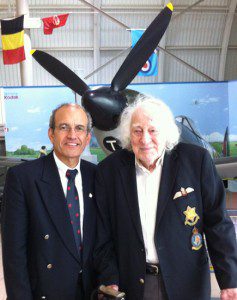
He wasn’t wearing his medals when I met George Weber, this week. Had he worn the ribbons and gongs – for his service in the U.K., the Mediterranean and Burma in the Second World War – they’d have no doubt looked pretty impressive. But his blazer with its air force pilot’s brevet and fighter squadron crest offered ample evidence of his wartime service.
Still, one aspect of Weber’s life in the war was not so obvious. He came from a Mennonite home near Kitchener and the Webers, he told me, did not believe in the use of guns. But as it turned out he was able to reconcile his religious beliefs and his loyalty to Canada.
“I didn’t shoot people during the war,” he said. “I ended up shooting pictures.”
In 1941, very much against his father’s wishes, a 22-year-old George Weber went to a recruiting office in western Ontario and enlisted in the army. It became evident very quickly that his family’s “conscientious objector” philosophy (a general condemnation of war for the bloodshed involved) conflicted with his basic army training. A cousin assisted his transfer to air force. And for a while, all George had to worry about were his flight controls, navigation skills, takeoffs and landings.
Then, his Elementary Flying Training School was visited by none other than former WWI fighter pilot Billy Bishop, who’d arrived to ensure the young air cadets were up to snuff. Bishop (the instruction inspector) and Weber (the guinea pig student) took off in a two-seater Fleet Finch.
“Bishop took me up to a thousand feet and told me to do a slow roll,” Weber said. “Well, I’d never done any aerobatics … but I ended up doing some unexpected low flying. … and I guess that’s why I ended up doing photo reconnaissance [in an unarmed Spitfire].”
With your understanding of my preoccupation of such things (and since I’ve just come back from D-Day observances overseas) I’ve often wondered how some men and women served in the armed forces, when their religious convictions in life did not align with the demands of their service. In particular, religious groups such as Quakers, Mennonites and Amish (among others) have historically refused to participate in armed service. Generally, such religions have believed they should remain neutral in worldly conflicts, that they had greater respect for humanity as a whole, or that no government had the right to command its citizens to go to war.
“Neither shall [we] learn war anymore,” they might quote from the Bible.
I never asked my father about such things (and I should have), but I sense his service as a medic in the Second World War might well have resulted from a form of conscientious objection. He’d grown up in a non-violent family environment. I know there was never a gun in his mother’s house (as there was never one in the house where my sister and I grew up). And while he went to Greek Orthodox Church most Sundays, my father’s view of war I don’t think was influenced by his religion. Years later, when I came across his attestation (enlistment) papers, I noticed in the “occupation” box he had written “sewing machine operator.”
It never occurred to me until someone made the connection between his occasional piecemeal work sewing furs (like his mother and future mother-in-law) and his wartime role of patching people up, that maybe his needlework had landed him in the U.S. Army Medical Corps, not his anti-war sentiment. Whatever the reason, I sensed my father survived the war very much the way George Weber did, by coping with its realities and putting up with its inconsistencies until clearly the bad guys were put out of action.
As I suggested, RCAF pilot George Weber adhered to his family’s abhorrence of violence and the principles of warfare pretty loyally. On almost every operation – more than 70 photo reconnaissance flights during the war – Warrant Officer Weber never pressed the button on his Spitfire control column with any other intention than to capture images of enemy positions.
He did however admit, in our interview this week, that he carried a 45-callibre pistol on his hip, just in case. And when pressed he said he’d used it once. On one of his flights over Japanese military positions in Burma, he attracted the attention of a Japanese Zero pilot. Weber said he managed to evade the enemy fire. But in an act of frustration – to ward off the enemy pilot – Weber said he was suddenly alongside the Japanese fighter pilot.
“I opened my cockpit cover enough to fire a couple of shots at the guy with my 45 to scare him off,” Weber said. “But my dad never heard about it.”
I guess a few warning shots across the bow of an enemy fighter didn’t violate either his promise to his father or the tenets of his Mennonite faith.